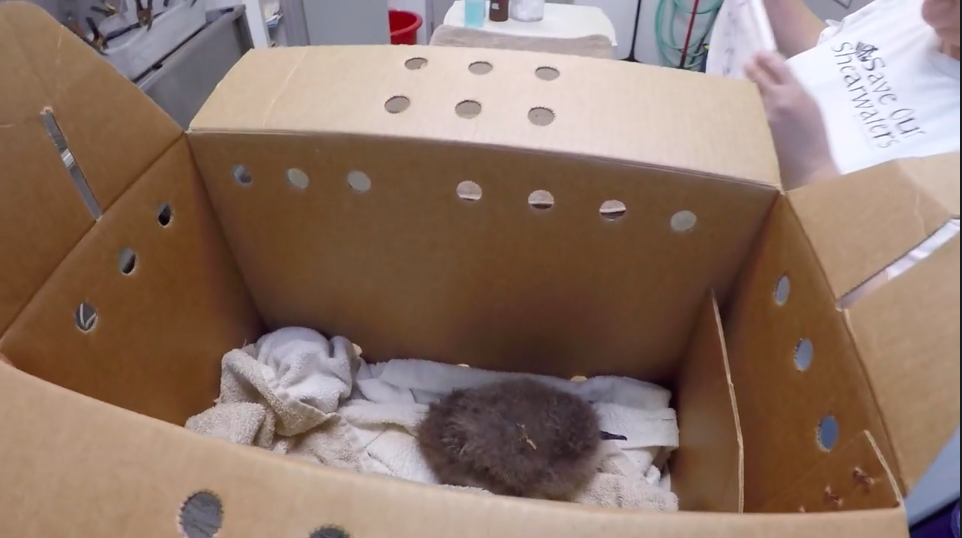09/04/16 – DLNR & YOU – Newell’s Shearwater Chick Avoids Cats & Rats In Kauai Mountains
Posted on Sep 4, 2016 in Forestry & Wildlife, News Releases, sliderDEPARTMENT OF LAND AND NATURAL RESOURCES
Joint News Release
| DAVID Y. IGE GOVERNOR |
SUZANNE D. CASE
CHAIRPERSON |
For Immediate News Release September 4, 2016

(click on image to watch video)
NEWELL’S SHEARWATER CHICK AVOIDS CATS & RATS IN KAUA‘I’S MOUNTAINS
Chick’s Rescue Provides Bright Spot in Battle Against Extinction
(Lihue, Kaua‘i) – A tiny Newell’s Shearwater chick, rescued from the Hono o Na Pali Natural Area Reserve on Kaua‘i, in late August, is thriving and doing well at the Save our Shearwaters (SOS) facility. The lost chick was collected by KESRP staff members, Heidi Ingram and John Hintze. They carried it up the side of a mountain to a helicopter landing zone on a remote ridge. The bird was put into a carry box and flown to Lihue where it was then taken to SOS at the Kaua‘i Humane Society.
“In all my years working with the endangered seabirds of Kaua‘i, we’ve never had something like this happen before,” said Dr. Andre Raine, Project Manager of the Kaua‘i Endangered Seabird Project (KESRP). “If we find chicks out on trails during the day, they are always dead; dragged out of their burrows and killed by feral cats or by rats. My guess is something happened to its parents and as it became more and more hungry, it left its burrow in search of food. We couldn’t locate its burrow and it was alone and extremely vulnerable to predators, so we had to rescue it and take it to SOS.”
Tracy Anderson, SOS Program Coordinator, gave it a thorough examination including weighing and measuring, checking for injuries (none), and an overall condition and health assessment. Anderson noted, “When this little bird came in, it was obvious it was very hungry…so hungry in fact it tried to eat my finger! We gave it fluids and a fish meal. Over the past week and a half it’s been eating well, is bright, alert and loving its food. We have high hopes it will be healthy enough to fledge later this year.” Raine observed, “This is such a boost in morale for everyone engaged in the work to save our endangered seabirds; Kaua‘i has 90% of the world’s population of Newell’s Shearwaters.”
In addition to the Newell’s Shearwater, KESRP also focuses on the Hawaiian Petrel. Kaua‘i has one of the largest breeding populations of petrels in the Hawaiian archipelago. KESRP also undertakes studies on Kauai’s most enigmatic seabird, the diminutive Band-rumped Storm-petrel, which is a Candidate for Listing. Very little is known about this rare seabird, which mainly breeds in the cliffs of the Na Pali coast.
“Both the Newell’s Shearwater and Hawaiian Petrel have declined dramatically in recent decades,” explained Raine. “As we suspect with the parents of the baby Newell’s Shearwater, in their remote mountain colonies these species are under siege from introduced predators such as cats, rats and pigs, while their habitat disappears under the onslaught of invasive plants such as ginger and guava. They also collide with power lines as they fly to and from the sea at night, and when their chicks finally leave the nest they are brought to the ground by artificial lights. They are truly iconic species that desperately need our help.”
The three seabird species are particularly hard to study, coming into the islands only at night and nesting in remote and steep terrain in the mountains of Kaua‘i. KESRP uses a wide range of high tech equipment and methodologies. Truck-mounted radar units are used at night to count birds as they move in and out of their breeding colonies to look at island-wide population changes over time. Sound recording devices are deployed from helicopters using grappling hooks into inaccessible areas and within managed colonies to record changes in the number of breeding birds in colonies each year. Night vision goggles are used by survey teams to count birds flying into colonies, and cameras are set at burrows to monitor predator interactions and bird behaviour. The team is also investigating a range of techniques – including lasers and bird diverters – to reduce collisions on power lines. All of this data is then used to help direct on-going management activities for this imperilled seabirds.
“The key to success is solid science coupled with fostering partnerships,” said Sheri Mann, Kaua‘i DLNR Division of Forestry and Wildlife Kaua‘i Branch Manager. “KESRP works closely with a wide range of partners, from the U.S. Fish & Wildlife Service, to NGOs such as the National Tropical Botanical Gardens and American Bird Conservancy, to KIUC – the island’s power company. This way we can ensure that management decisions are well informed and effective. This helps conserve the seabirds and equally importantly, our watersheds on which they and everything else depend.”
A one-half hour television special, The Endangered Seabirds of Kaua‘i debuts on KFVE-TV (K5) tonight at 6:30 p.m., with a repeat scheduled for Sunday, Sept. 10, 2016 at 6:00 p.m. The DLNR & YOU special, supported by the Hawai‘i Tourism Authority, highlights many of the efforts and research projects underway to save Kaua‘i’s endangered seabirds.
The Kauai Endangered Seabird Recovery Project is a joint project between DLNR/DOFAW and PCSU/RCUH.
# # #
Media Contact:
Dan Dennison
Senior Communications Manager
(808) 587-0407
[email protected]
